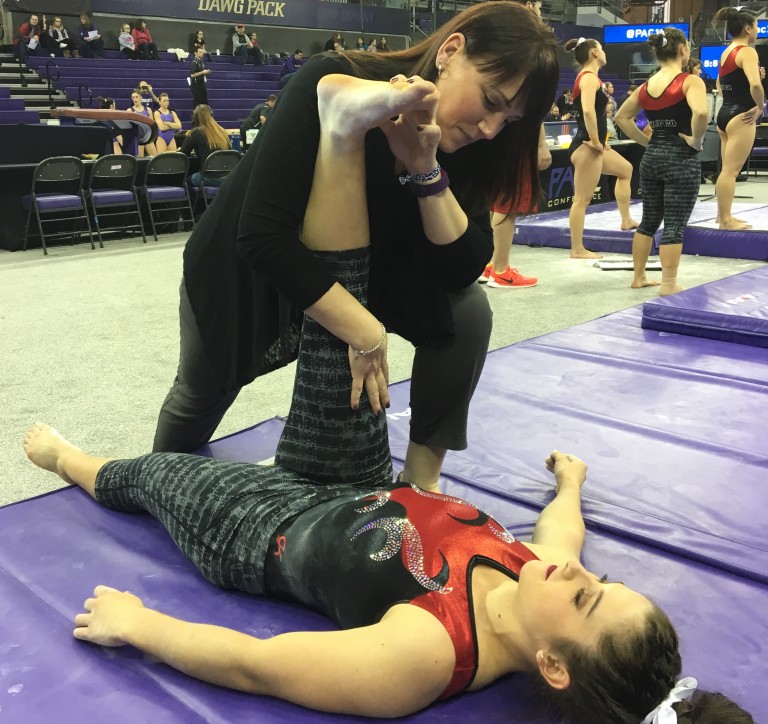
When I got a call from Stanford athletic trainer Sarah Lyons recently, I was a bit confused. Sure, Scope covers fitness as it relates to overall health, but we’re not in the business of chronicling sports. And aren’t athletic trainers just for elite athletes: pro football players and top sprinters and the like?
Well, no, Lyons (shown at right working with a Stanford gymnast) told me. And, she said, I’m not the only one with a few questions about athletic trainers. So, to educate myself and to honor National Athletic Training Month, I shot Lyons, who serves as the athletic trainer for Stanford women’s gynmastics and men’s rowing, a few questions:
So – athletic trainers aren’t just for elite athletes?
No. You can find athletic trainers working with athletes at all levels (youth sports, high school, college/university, recreational and professional sports). You can also find athletic trainers in corporations, the military, performing arts, clinics, hospitals and physicians’ offices.
Are trainers considered health-care workers, and do physicians typically understand their role?
Yes. Athletic trainers are health-care professionals who collaborate with physicians to provide preventative services, emergency care, clinical diagnosis, therapeutic intervention and rehabilitation of injuries and medical conditions. Athletic training is recognized by the American Medical Association as a health-care profession.
Physicians who work in sports medicine or work closely with athletes who train at the collegiate and professional level understand the role of an athletic trainer, but there are a wide variety of physicians who don’t…
What do you wish everyone would know about athletic trainers?
Athletic trainers are sometimes confused with personal trainers. There is a large difference between the education, skill set, job duties and patients of an athletic trainer and a personal trainer. The athletic training academic curriculum and clinical training follows the medical model. Athletic trainers must graduate from an accredited baccalaureate or master’s program, and 70 percent of athletic trainers have a master’s degree. It is important to all of us in our profession to be referred to as an athletic trainer instead of a trainer.
What are the career prospects for future athletic trainers? What types of interests and experiences should they have?
The future of athletic training is bright. According to the U.S. Department of Labor, employment of athletic trainers is projected to grow 21 percent from 2014 to 2024. As people become more aware of sports-related injuries at a young age, demand for athletic trainers is expected to increase, particularly with youth sports. There are several career paths for athletic trainers such as working in college and universities, secondary schools, professional sports, education or occupational health. In addition, currently over 80 percent of athletic trainers hold a master’s degree or higher.
Do athletic trainers have to be good athletes? Not at all… luckily! Several athletes have gone on to become athletic trainers but any prospective clinician who is interested in the diagnosis, treatment and rehabilitation for sport and/or non-sport related injuries can become an athletic trainer. Having a general understanding for the sport for which you are the athletic trainer for is helpful but not a necessity, and can be learned on the job. Being skillful in the prevention, treatment and rehabilitation of injuries is most important.
Previously: A focus on the growing athlete, Thinking through return-to-play decisions in sports medicine and Sports medicine specialists, educators endorse checklist to reduce injuries among youth athletes
Photo courtesy of Sarah Lyons
– See more at: http://scopeblog.stanford.edu/2016/03/25/an-inside-look-at-athletic-training/#sthash.QiZrHYuK.dpuf